Affiliate Disclosure: This post may include affiliate links. If you click and make a purchase, I may earn a small commission at no extra cost to you.
The Samsung 990 EVO Plus is a relatively new addition to the Samsung SSD lineup. It is a DRAMless SSD designed for low and medium-end users. Although it’s a Gen 5.0 drive, it uses only half the bandwidth because it runs on two Gen 5 lanes. There are many other competitors to the 990 EVO Plus, but we are comparing it with the 990 Pro because of its competitive price while being a Gen 5.0 SSD. The performance numbers of both look almost similar.
Just like others, you are probably thinking, “Why spend 40 to 50 bucks more on a 1TB 990 Pro when we can get the 1TB 990 EVO Plus, which is Gen 5.0, for a cheaper price?” Well, there are many factors to consider besides price.
The 990 Pro has the most significant advantage: DRAM. It helps in various scenarios, including situations where constant performance under heavy workloads is required. The 990 EVO Plus, as part of the EVO series, is targeted at mid-range users. So, a lack of DRAM could work in their favor. But there are surely some disadvantages when you pick a DRAM-less SSD over a DRAM-equipped one.
However, the 990 EVO is not a bad SSD at all. First of all, it has a much better controller based on 5nm technology. The V-NAND V8 with 236 layers is much more refined than the 990 Pro’s V7 NAND with 176 layers, though the latest 2TB and 4TB models of the 990 Pro have been upgraded to V8 236 layers. It runs cooler and consumes less power than the 990 Pro. But, performance-wise, the 990 Pro is always going to win.

All in all, the 990 EVO Plus promises many things, but will it be able to prove itself? This is what we will reveal in this comparison.
Theoretical Specifications
| Specification | Samsung 990 PRO | Samsung 990 EVO Plus |
|---|---|---|
| Storage Variants | 1TB, 2TB, 4TB | 1TB, 2TB, 4TB |
| Form Factor | M.2 (2280) | M.2 (2280) |
| Interface | PCIe® Gen 4.0 x4, NVMe™ 2.0 | PCIe® Gen 4.0 x4 / 5.0 x2 NVMe™ 2.0 |
| NAND Flash Memory | Samsung V-NAND 3-bit MLC | Samsung V-NAND TLC |
| Controller | Samsung Pascal (S4LV008) | Samsung Piccolo (S4LY022) |
| DRAM Cache Memory | 1TB: 1GB LPDDR4 2TB: 2GB LPDDR4 4TB: 4GB LPDDR4 | HMB (Host Memory Buffer) |
| Sequential Read Speed | Up to 7,450 MB/s | 1TB: Up to 7,150 MB/s 2TB & 4TB: Up to 7,250 MB/s |
| Sequential Write Speed | Up to 6,900 MB/s | Up to 6,300 MB/s |
| Random Read (QD32) | 1TB: Up to 1,200,000 IOPS 2TB: Up to 1,400,000 IOPS 4TB: Up to 1,600,000 IOPS | 1TB: Up to 850,000 IOPS 2TB: Up to 1,000,000 IOPS 4TB: Up to 1,050,000 IOPS |
| Random Write (QD32) | Up to 1,550,000 IOPS | 1TB & 2TB: Up to 1,350,000 IOPS 4TB: Up to 1,400,000 IOPS |
| Price | 1TB starting from 109.99$ | 1TB starting from 84.99$ |
The EVO Plus supports “either” Gen 4×4 or Gen 5×2. So, what does that mean? If your motherboard supports Gen 5×2 lanes in an M.2 slot (which generally has four lanes), then the EVO Plus might give you an edge. If not, you’re running it at Gen 4×4 anyway, so you’re not getting much extra here.
The Samsung 990 PRO clearly targets the high end, with faster read and write speeds and higher IOPS across the board compared to the 990 EVO Plus. It also uses a dedicated LPDDR4 DRAM cache, while the EVO Plus relies on host memory, which can hurt performance under sustained loads. The PRO’s Pascal controller and 3-bit MLC NAND (TLC) give it better durability and consistency, whereas the EVO Plus, with TLC NAND, focuses more on affordability and efficiency.
The 990 EVO Plus isn’t slow by any means; it’s still plenty fast for gaming, everyday work, and even light creative tasks, but the 990 PRO is the better fit for power users, professional workloads, and anyone who pushes their system hard.
Benchmark Scores Comparison
The benchmark scores are organized by reviews of these SSDs from various websites. The list includes Tom’s Hardware, PCWorld, PCMag, etc. The sources are linked at the end. However, I am fully responsible for the accuracy of the data.
PCMark10 Storage Benchmark
PCMark 10 is another trace-based synthetic benchmark that simulates real-world environments to test SSD performance. This test shows the performance of the tasks we do daily. A better score means a better SSD’s real-world performance.
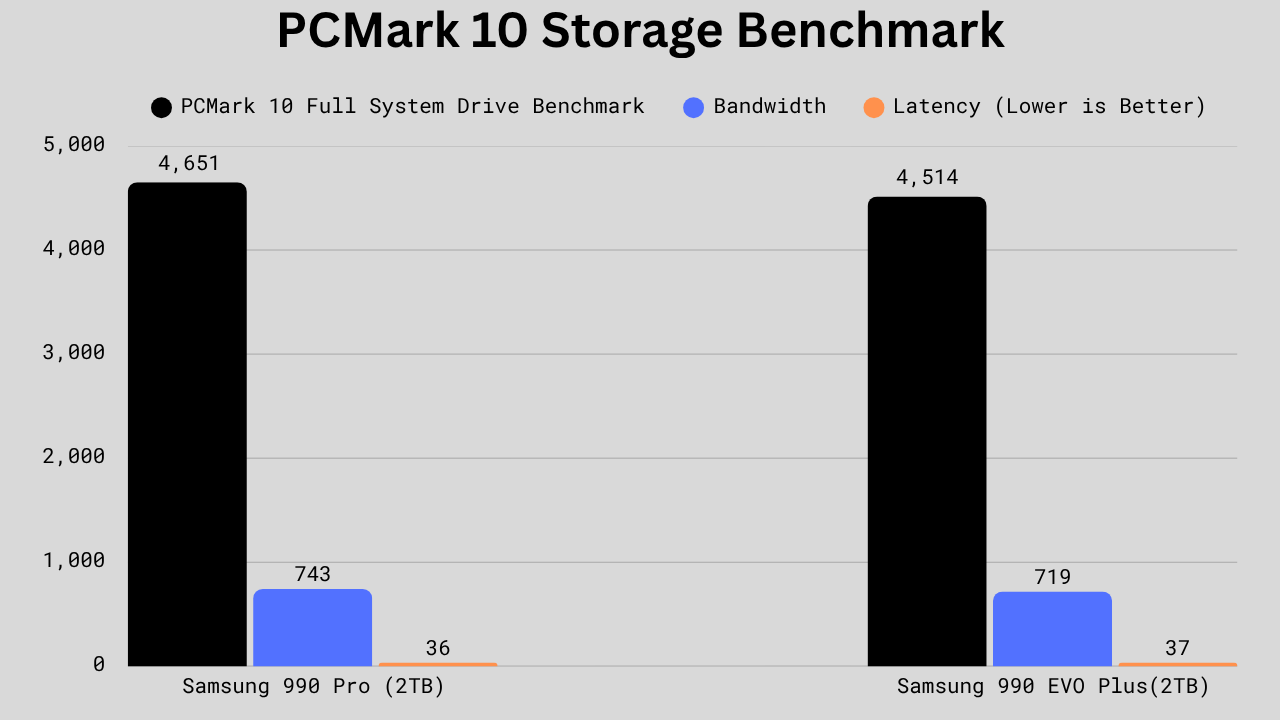
In the PCMark 10 Full Drive Benchmark, the Samsung 990 Pro leads across the board. It got the overall PCMark 10 score of 4,651 compared to the 990 EVO Plus’s 4,514 (~3% higher). The bandwidth of 990 Pro came out to be 743 MB/s vs 719 MB/s of 990 EVO Plus (~3.3% higher). The latency is lower by one microsecond, 36 µs vs 37 µs (~2.7% lower, which is better). Overall, the 990 Pro is slightly faster and a bit more responsive than the 990 EVO Plus. Although the gap is small, it is consistent.
3DMark Storage Benchmark
The 3DMark storage test simulates the gaming environments and tests an SSD’s performance. It returns an overall score along with latency and bandwidth. A higher 3DMark score means better gaming performance across criteria like game loading, saving, streaming, and installation.
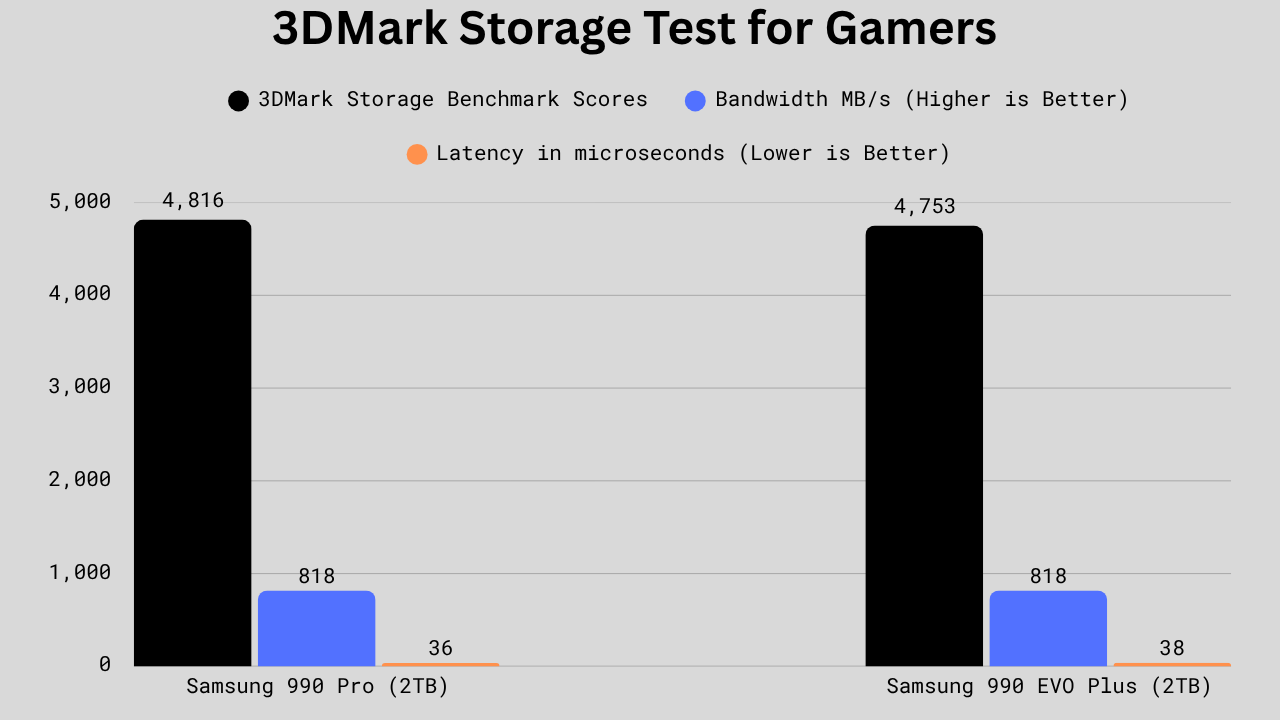
In the 3DMark Storage test, the Samsung 990 Pro keeps a slight but clear edge over the 990 EVO Plus. It scores 1.3% higher overall (4,816 vs 4,753) and matches the EVO Plus in bandwidth at 818 MB/s, while also showing slightly lower latency (36 µs vs 38 µs). The differences are tiny, but the Pro is just a touch more responsive, especially under heavier gaming or application loads.
CDM Sequential Read/Write Scores
For the CrystalDiskMark sequential performance test, we used a 1MiB file size with a Queue depth of 1 and 8.
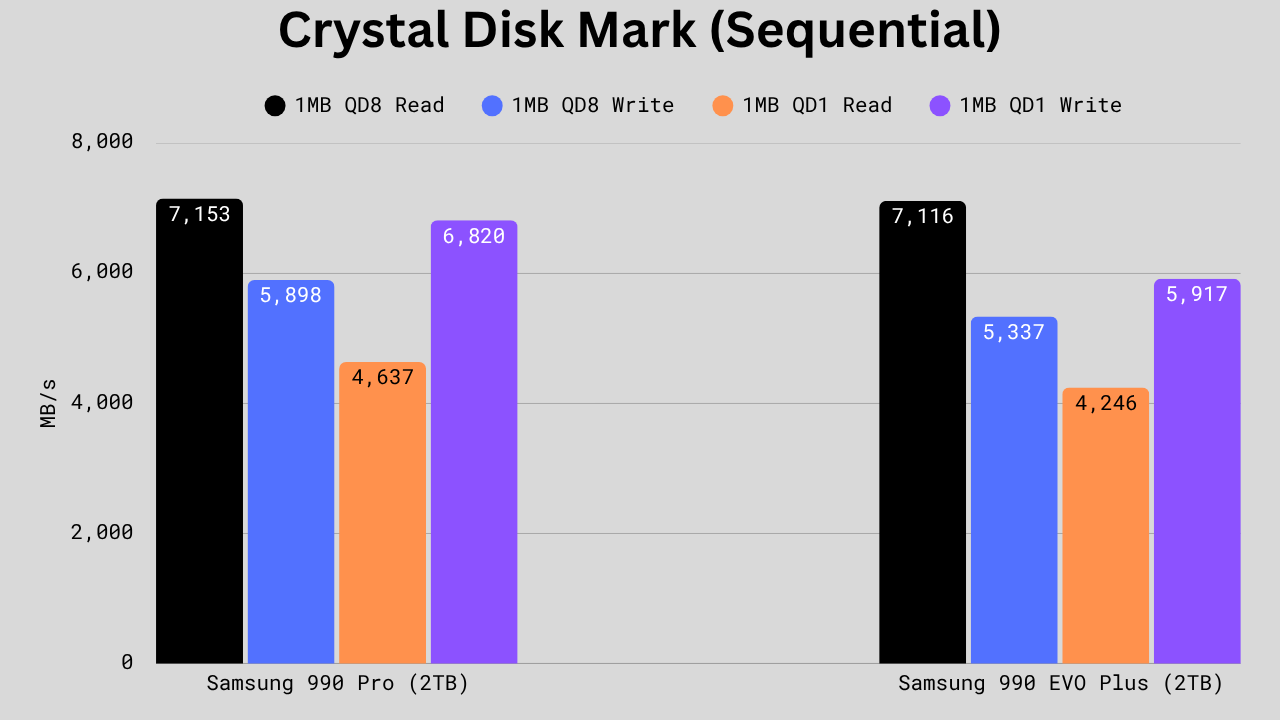
In sequential performance, the Samsung 990 Pro clearly pulls ahead of the 990 EVO Plus. Its QD8 read and write speeds are about 1% and 10% faster (7153 vs 7116 MB/s) and (5898 vs 5337 MB/s), respectively, while QD1 read and write speeds jump by roughly 9% and 15%, respectively. These gains mean the 990 Pro handles both large and small file transfers with a bit more punch, especially in tasks like game loading or media editing.
CDM Random Read/Write Scores
For the random read/write performance comparison, we are taking the 4K test at QD1 and QD256. Let’s see the results.
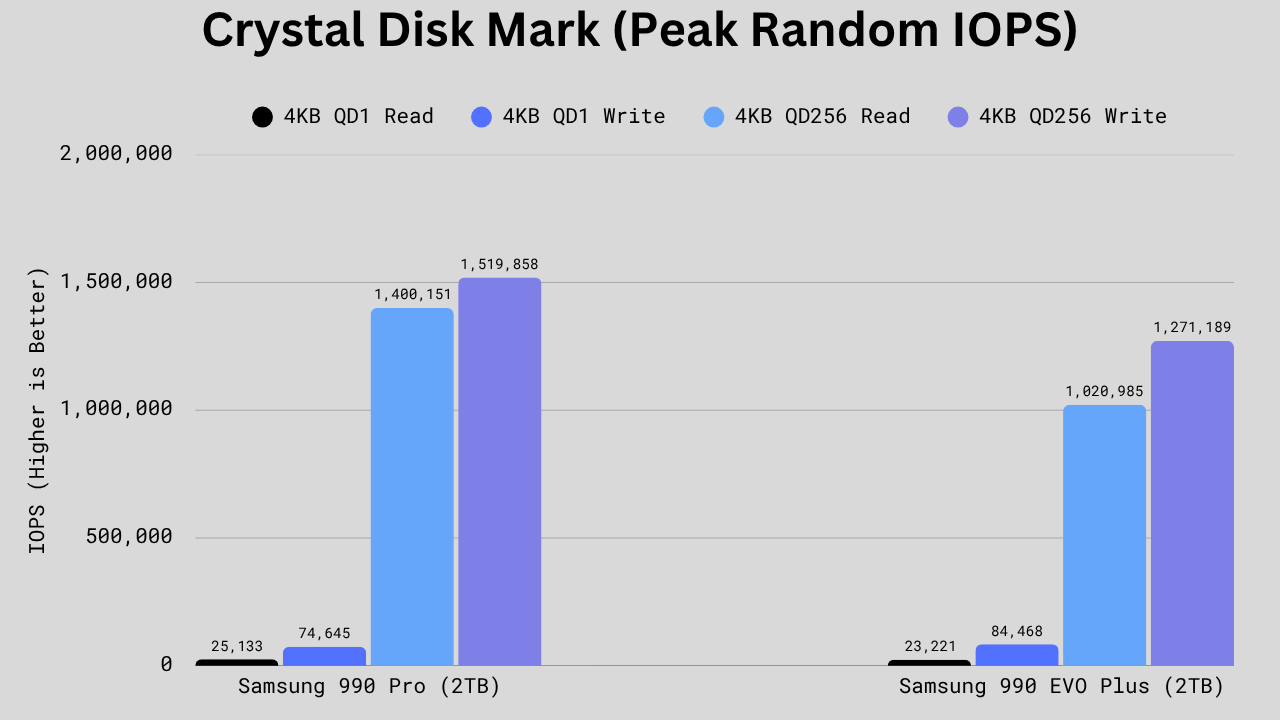
In random performance, the Samsung 990 Pro shows a strong lead overall. It’s about 8% faster in 4KB QD1 reads, though the EVO Plus actually beats it by roughly 13% in 4KB QD1 writes. When the queue depth ramps up, though, the 990 Pro dominates. Its QD256 read IOPS are 37% higher, and QD256 write IOPS come in almost 20% faster. In short, the 990 Pro handles heavier multitasking and demanding workloads far better, while the EVO Plus holds up fine for lighter, everyday operations.
Transfer Rate – DiskBench
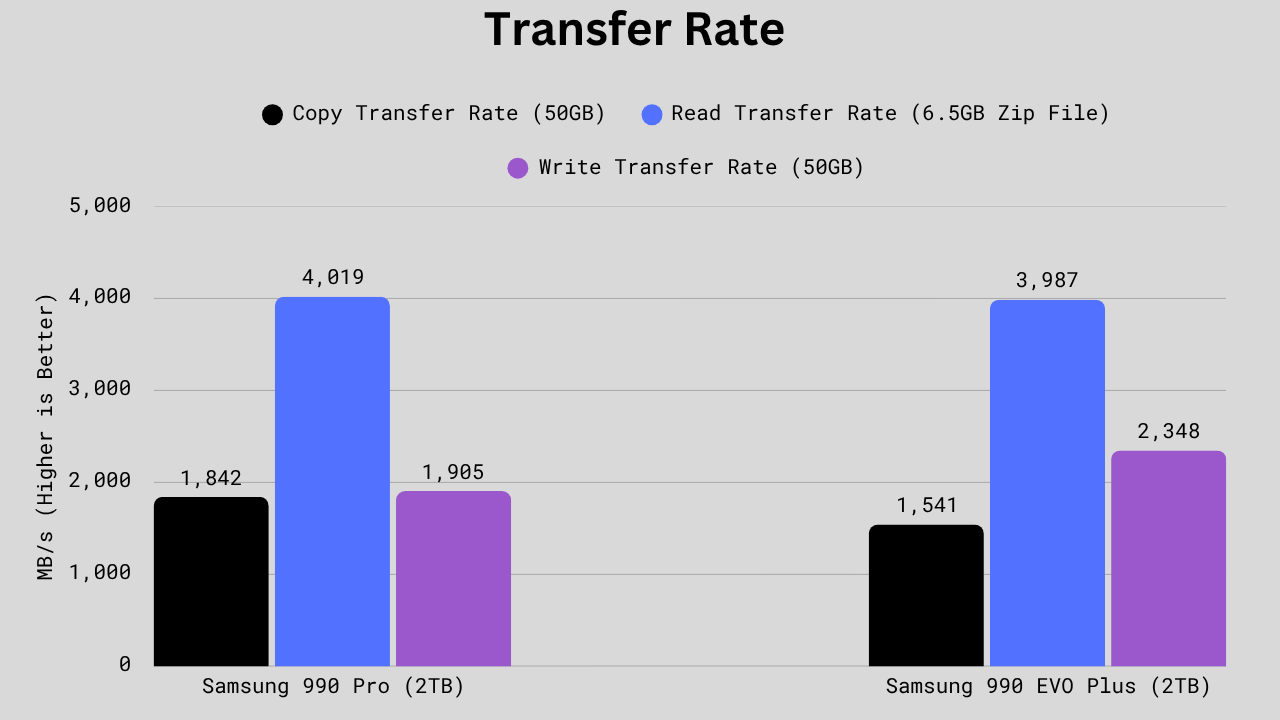
In large file transfers, the Samsung 990 Pro and 990 EVO Plus trade blows. The 990 Pro is around 20% faster in the 50GB copy test (1,842 vs 1,541 MB/s) and slightly edges ahead in the 6.5GB read test, but the EVO Plus wins on writes, pushing 23% higher (2,348 vs 1,905 MB/s). The Pro feels more balanced overall, but if your workload involves heavy, sustained writing, the EVO Plus might actually perform better.
Power Consumption (Quarch PPM)

In terms of efficiency, both drives are neck and neck with 467 MB/s per watt and 4 W average power draw during a 50 GB copy. The real difference shows at idle: the EVO Plus sips just 839 mW versus the Pro’s 1,252 mW, making it noticeably more power-friendly when the system’s idling. Max power use is identical at 6 W. So, the 990 Pro performs harder; the EVO Plus runs cooler and wastes less energy sitting still.
Thermals
Both of the SSDs are no doubt pretty efficient in handling the load. During most of the benchmarks, the 990 EVO Plus reached the maximum of 70°C and 65°C in Tom’s Hardware tests. The 990 Pro, on the other hand, runs hotter, and goes up to 80°C and even above in some benchmarks like this one from TechPowerUp. However, these temperatures are only when these drives are tested without heatsinks. So, if you are planning to put a heavy load on them, going for a drive will prevent them from overheating.
Technical Specifications
| Specification | Samsung 990 Pro | Samsung 990 EVO Plus |
|---|---|---|
| Controller | Samsung’s Pascal (S4LV008) | Samsung Piccolo (S4LY022) |
| Controller Architecture | ARM 32-bit Cortex-R8 | ARM 32-bit Cortex-R8 |
| DRAM Specifications | Samsung’s LPDDR4 DRAM 1TB: 1×1024 MB 2TB: 1×2048 MB 4TB: 1x 4096 MB | None (Host Memory Buffer) |
| SLC Write Cache | 1TB: approx. 114 GB (108 GB Dynamic + 6 GB Static) 2TB: approx. 226 GB (216 GB Dynamic + 10 GB Static) 4TB: approx. 442 GB (432 GB Dynamic + 10 GB Static) | 1TB: – approx. 114 GB (108 GB Dynamic + 6 GB Static) 2TB: approx. 226 GB (216 GB Dynamic + 10 GB Static) 4TB: approx. 442 GB (432 GB Dynamic + 10 GB Static) |
| NAND Flash | Samsung’s V8 V-NAND TLC | Samsung’s V8 V-NAND TLC |
| Topology | 236-Layers | 236-Layers |
| NAND speed | 2400 MT/s | 2400 MT/s |
| Read Time (tR)/Program Time (tProg) | 40 µs/390 µs | 40 µs/390 µs |
| Die Read Speed | 1600 MB/s | 1600 MB/s |
| Die Write Speed | 164 MB/s | 164 MB/s |
| Encryption | AES-256, TCG Opal | AES-256, TCG Opal |
| SMART/TRIM/PS5 Support | Yes/Yes/Yes | Yes/Yes/Yes |
| More Information | Check Datasheet | Check Datasheet |
Both the Samsung 990 Pro and 990 EVO Plus use the same NAND architecture: a 236-layer V8 TLC running at 2400 MT/s. But the key difference lies in memory handling and controller design. The 990 Pro uses Samsung’s Pascal controller with onboard LPDDR4 DRAM, while the EVO Plus relies on the Piccolo controller and a Host Memory Buffer (HMB) instead of dedicated DRAM.
That means the Pro has faster access to its mapping tables, especially under sustained workloads or heavy multitasking, while the EVO Plus leans on system RAM to cut costs. Aside from that, both drives offer identical SLC caching structures, encryption support, and PS5 compatibility. The 990 Pro suits performance-driven setups or professional use, whereas the EVO Plus makes more sense for efficient, budget-focused builds. The 990 Pro also has the heatsink variant if you want to opt for that.
But all in all, the 990 Pro has other advantages over the 990 EVO Plus in terms of technical specifications. The biggest drawback of the 990 EVO Plus is that it doesn’t have DRAM (has HMB).
Endurance, Warranty, and TBW
| Specification | Samsung 990 Pro | Samsung 990 EVO Plus |
|---|---|---|
| Warranty | 5 years | 5 years |
| TBW | 1TB- 600 TBW 2TB- 1,200 TBW 4TB- 2,400 TBW | 1TB- 600 TBW 2TB- 1,200 TBW 4TB- 2,400 TBW |
| MTBF | 1.5 Million Hours | 1.5 Million Hours |
There is no difference if we look at the reliability factors. Warranty, TBW, and MTBF are the same, so there is nothing to be discussed here.
Price


Samsung 990 Pro vs Samsung 990 EVO Plus: Which one should you choose and why?
If you don’t plan to put your SSD under heavy read/write load and are happy with an average drive, the Samsung 990 EVO Plus is a good pick, saving you a good amount of money for the same storage space. It is more power-efficient, cooler, and designed for everyday users. However, performance isn’t compromised much, as we saw in the benchmarks above. It doesn’t have DRAM, and this can harm performance in sustained and random workloads. Still, the HMB technology in DRAM-less has become quite advanced, and you may not notice any issues in day-to-day use.
You should choose the Samsung 990 Pro if you are interested in the best possible performance with the PCIe 4.0 interface. It is more expensive than the 990 EVO Plus, but it proves itself under heavy workloads. Nothing is compromised with the 990 Pro. But you’ll have to pay for it. If you think you are an enthusiast or are on the way to becoming one, you should go for the 990 Pro.

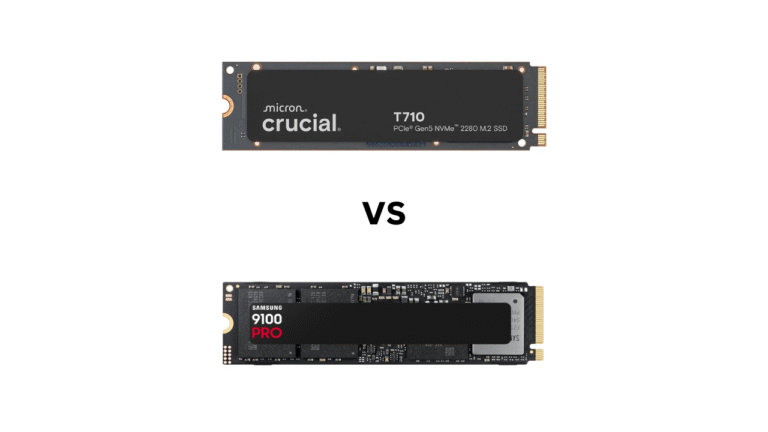
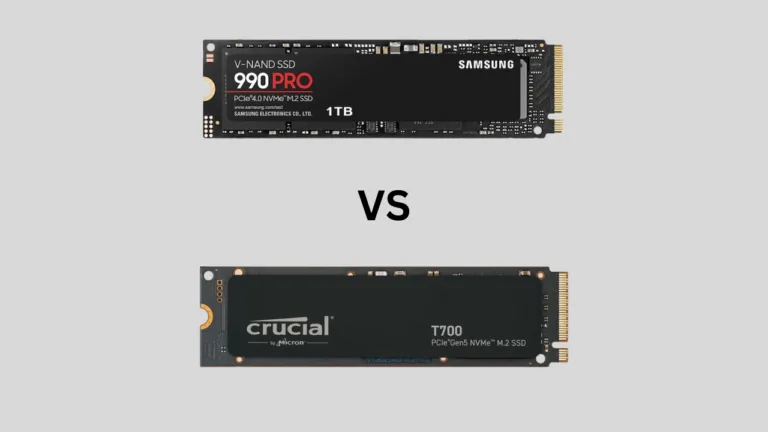


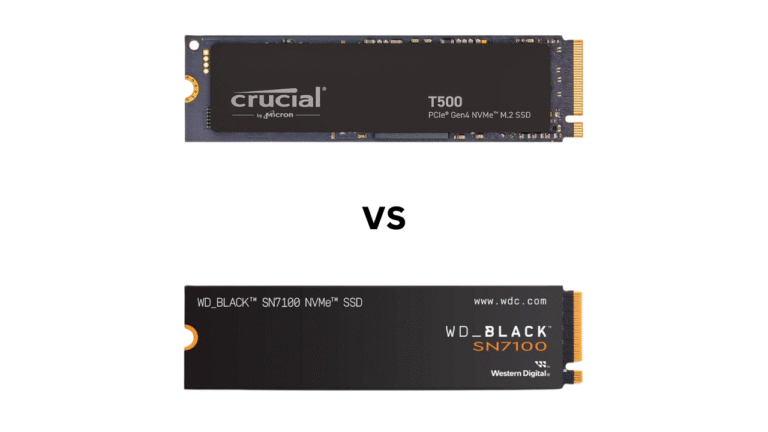
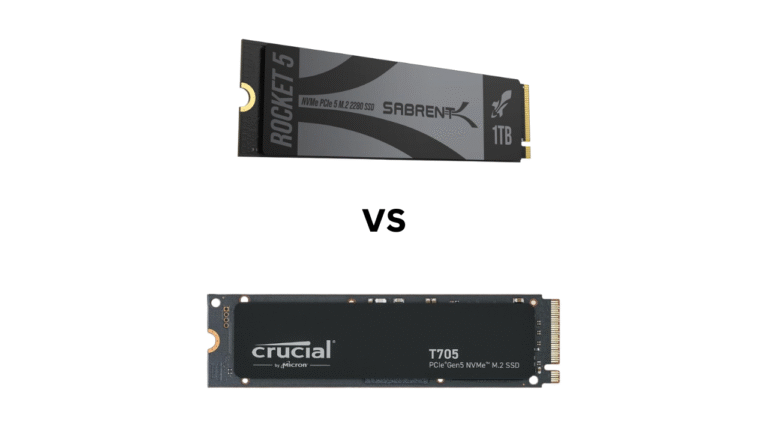
You’ve got the wrong SSD in the picture.
The article is about the 990 Evo Plus vs 990 pro.
The picture is a 990 Evo Plus and and a 980 pro.
Fixed the image. I appreciate your feedback.
HEY , if I am looking for an upgrade on laptop ssd which is only compatible with interface 3 but I would like high TBW which both of these offer – would I notice any difference in performance between them ? thanks
There would be no visible difference in the performance because there is a bottleneck at Gen 3.0 speed. You may get a little better random performance with the 990 Pro but that too not very substantial. So, in your case, you will get almost same performance benefits.
Thank you very much
Hello, I wonder how does the technology change affect the dangers of losing data with power outage. If we can lose data with power outage with DRAM, what happens with the new version without DRAM.
Most SSDs these days (both DRAM and DRAM-Less) come with Power-Loss protection with capacitors that allow them to finish writing data to flash storage when power is lost, reducing corruption. With that said, both 990 EVO and 990 EVO Plus neither have DRAM nor PLP. So, you are right that the companies are putting our data at risk for profits but its disappointing to see.
Thanks, nice review. The graph about power consumption is hard to read: two of the bars are lower is better and the other is higher is better, a bit confusing
Hi N1mda, I understand the confusion. I will create separate graph for power effeciency i.e. MB/s per watt. Thanks for pointing that out.
PCMark and 3DMark scores are almost similar. I don’t think there is any point going for the 990 Pro with outdated components. DRAM in the is the only better thing with 990 Pro I guess.
I thought 990 EVO plus had DRAM cache….
The article’s solid overall, but you should have given thermal information. Let me compare that here.
I am sure this will be a serious concern for some people. I chose to go for 990 Pro because of its better sustained performance and DRAM but I opted for the heatsink variant and it works flawlessly even when I am working with large datasets.
That is a good addition to the article. I appreciate your efforts.
I rather think you should at least address it – I build toaster-sized mini-ITX builds and this article doesn’t show me the full picture and I wouldn’t know that without knowing to read the comments and hope someone contributed. I’d love a test of the heat-sink equipped Pro, but I’d settle for the information.
Hi Kevin, thanx for pointing this out. I have added the thermals section in the comparison. If you are confused in the regard, let me clear it for you. The Samsung 990 Pro generally runs hotter compared to the 990 EVO Plus. So, if you are planning for it, go for the heatsink version or install the one that comes with your motherboard. Thanks.
So… The 990 pro is barely better than the 990 evo plus, more expensive and less energy efficient (i’m guessing that the pro runs hotter than the evo plus, therefore it has lower life expectancy). I’m gonna go with the 990 evo plus! Thanks!
Yes, the components in the 990 EVO Plus are much effecient and also the DRAM-Less design makes it run cooler. However, 990 Pro is best if you are looking for the best performance between the both. Otherwise, 990 EVO Plus is good enough. Thanks.
What is the job of DRAM in an SSD? The 990 EVO Plus looks good, even though it lacks DRAM. How does it make a difference?
DRAM in an SSD acts as a high-speed cache for the Flash Translation Layer (FTL) which is the mapping table that keeps track of where every piece of your data actually lives in the NAND chips. When an SSD doesn’t have DRAM, it usually compensates using Host Memory Buffer (HMB), which borrows a small chunk (typically 32–64 MB) of your system’s RAM over PCIe/NVMe.
Without DRAM, every time the SSD needs to read or write something, it has to:
1. Fetch the mapping info from the NAND or HMB (slow),
2. Then read/write the actual data (also slow).
All in all, it results in a bad overall performance compared to a DRAM SSD with the same specifications.